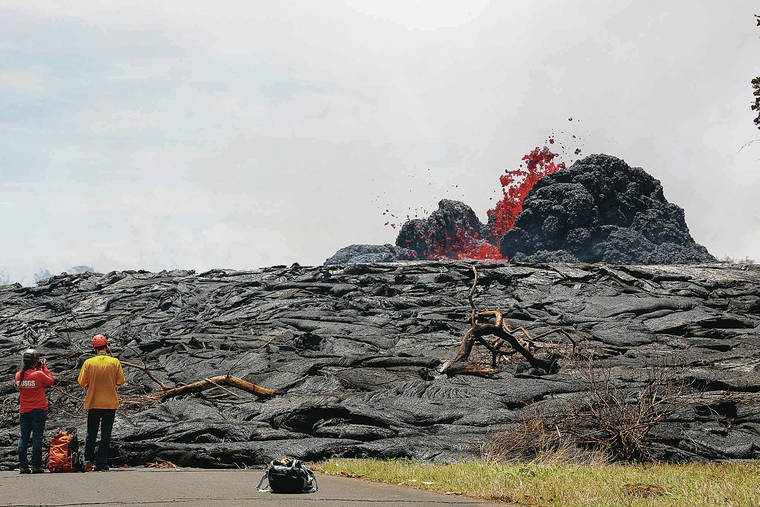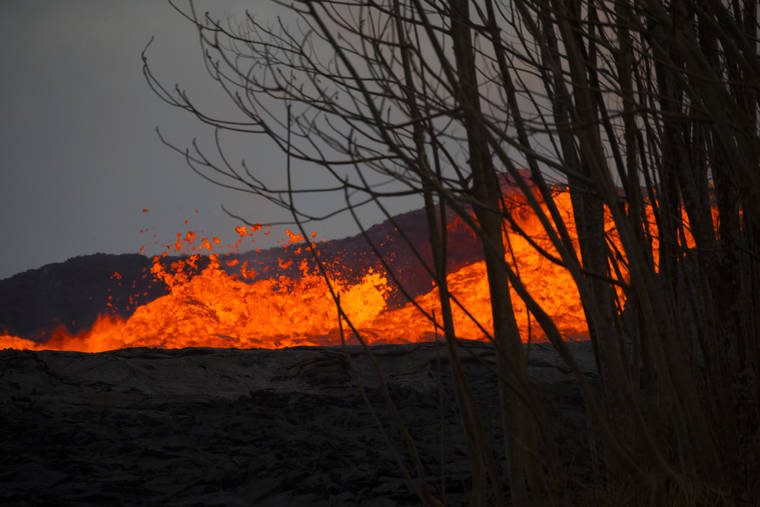A Hawaiian volcano deity whose name means “forest eater” is among 17 public suggestions submitted to a state board to become the official name of the most prominent source of lava during last year’s eruption of Kilauea.
Four designees of the Hawaii Board on Geographic Names are expected to make recommendations on the naming effort to the seven-member board by the end of the year, perhaps at a meeting in the Puna region of Hawaii island where the devastating eruption took place.
Most of the lava emanated from what began as a split in the ground referred to by U.S. Geological Survey scientists as fissure 8.
Fissure 8 was the eighth of 24 earth fissures that spewed lava initially within the rural Leilani Estates subdivision in Pahoa. It grew to be the dominant and longest-lasting eruption point from which magma spouted more than 200 feet into the air. Today, a roughly 100-foot-tall cinder cone surrounds the spot.
The first name submission for the mound, or puu, was Puu Leilani received by the board in August 2018, which was about when the eruption ceased after destroying roughly 720 homes, numerous farms, roads and recreational sites.
Since then, community members in Puna and beyond have been encouraged to submit applications to the board, which arranged two public meetings in Pahoa on the issue in May and September that fostered discussion of submissions and the selection process.
“We’ve never done this specific process before,” Renee Pualani Louis, an adviser to the board and member of the “permitted interaction group” tasked with submitting recommendations to the board, told the Hawaii County Council at a meeting last week.
The interaction group, which also includes three board members, was formed in February. The group set a June 30 deadline to submit fissure 8 name applications, and the board received 17 submissions by the deadline.
Louis told council members that community consultations have helped the board, but she also noted that some public feedback has criticized the process.
The board was established in 1974 to assure uniform spelling and use of geographic features in Hawaii. The board can act on applications to name previously unnamed features or to change official names, and its process for doing such things has evolved over the years.
The board has members representing the state Office of Planning, Office of Hawaiian Affairs, Bishop Museum, state Department of Hawaiian Home Lands, University of Hawaii and state Department of Land and Natural Resources.
The volunteer board is also relying on community input, Hawaii County officials and research experts.
Official names for geographic features are important because they get added to state and county government maps and documents. Names selected by the board also get referred to the U.S. Board on Geographic Names, which dictates such names for federal agency use.
For fissure 8, some suggested names have emotional and spiritual ties to people who were displaced by the eruption or personally connected to the area.
Mahealani Kaiwikuamo‘okekuaokalani-Henry said in her application that her family, as Puna residents for generations, takes a special interest in naming fissure 8. She suggested Keahiluawalu O Pele, a name referencing the Hawaiian volcano goddess Pele that came to her in a dream from ancestors.
“Pele is on display, she brings forth the fires, and birth of this land,” Kaiwikuamo‘okekuaokalani-Henry sang as part of a song to present her name suggestion to the Hawaii County Council at its Nov. 5 meeting.
‘Several name submissions described in applications refer more simply to features of lava or its impacts — such as Keahilapalapa (spreading or blazing fire), Ke Ahi ‘Ena‘ena (raging fire), Pohaka‘ena (exploding rage) and Pu‘u ‘O Luku (hill of destruction).
Others refer to places such as Luana-Lani, which is a name suggested because fissure 8 was at the intersection of Luana and Leilani avenues.
Two name suggestions reference ‘Ai La‘au, the name of a Hawaiian volcano deity who Pele is said to have displaced at Kilauea. These two suggestions are Pu‘uo‘aila‘au and Ahu‘aila‘au. Ahu can mean mound or alter. ‘Ai refers to one who eats or devours; la‘au means tree or forest.
Donna Walker, who moved to Leilani Estates as a child in 1970, told the County Council at last week’s meeting that her ohana, or family, has a preference for Ahu‘aila‘au.
“As an ohana of over 50 people who were raised on the property for 49 years, we support the Ahu‘aila‘au name, and — um — we will dearly miss our home, as it is under the fissure,” she said.
After selecting a name for fissure 8 from public submissions, the board is expected to take up a similar task to process public applications to name other features of the eruption, including other fissures and the main lava flow channel stretching eight miles to the ocean.




